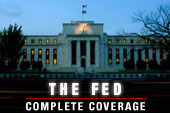The Federal Reserve’s announcement – as widely anticipated as yesterday’s unveiling of Apple’s new iPhone – that it would step into the breach once more and begin an open-ended bond-buying program in hopes of reviving the economy caused delight to stock market investors.

For starters, the central bankers will be buying $40 billion a month of mortgage-backed securities from agencies like Fannie Mae. Not only did the Fed make a point of emphasizing that it will continue to do so as long as need be, but it will continue with “Operation Twist” (an attempt to push down long term rates by selling shorter-term Treasury securities and buying their longer-term counterparties). If that still doesn’t do the trick, and spark some kind of revival in the jobs market? Well, the Fed said it would keep going, and deploy “other policy tools” as necessary.
What this all amounts to is a bold new approach by the Fed: a minimum commitment of $85 billion a month for the foreseeable future – or until there are signs of a sustainable recovery – with the prospect that central bankers will do still more. What they will get in return is far from certain, but it’s likely that at least some of those celebrating today may not be quite as happy about QE3 in a few months’ time.
Here’s a quick run-through of some of the possible implications of the Fed decision:
The Stock Market
In the wake of the Fed’s announcement, major indexes rocketed to the highest levels they have seen in years. But it’s not clear that they’ll sustain those gains. Analysts are predicting a sharp drop in corporate earnings for the third quarter, and the mere announcement of QE3 isn’t enough to keep sentiment bullish for all that long. Last time around – the announcement of QE2 – it turned out that stocks rallied more before the program made its debut than while it was in operation.
Result: Bullish as the central bank’s action boosts confidence, possibly turning bearish weeks from now as earnings grab the headlines and what some have called the “sugar rush” of Fed easing fades.
Financial Stocks
They must be cracking open the champagne on Wall Street. When the Fed buys securities in programs like this, it buys them from dealers. That means there are some sweet trading and arbitrage opportunities available for those crafty Wall Street traders. The stocks of Bank of America Merrill Lynch (BAC, up 4.79 percent) Goldman Sachs (GS, up 2.06 percent), JP Morgan Chase (JPM, up 3.71 percent) and Morgan Stanley (MS, up 2.76 percent) all surged after the Fed announcement.
Result: Windfall!
Gold
The precious metal hit a six-month high in the wake of the Fed’s announcement; it is priced in dollars, so it has become cheaper to hold. And it is widely viewed as an alternative currency, a hedge against possible inflation that might follow so much Fed stimulus. Given the bearishness and open-ended nature of Fed policy, odds are that gold will stay high – certainly relative to other assets.
Result: Bullish.
Jobs and the Economy
At last month’s Fed get-together in Jackson Hole, Wyoming, Ben Bernanke cited research that indicates the $2.3 trillion it cost to complete the first two rounds of quantitative easing, together, helped lower the yield on the 10-year Treasury note by a full percentage point and created about 2 million jobs. But the economic engine didn’t catch fire and begin powering along under its own momentum, picking up when the Fed left off.
The Holy Grail for Bernanke is to drive down the stubbornly high unemployment rate and spark new job creation. The Fed can’t stick guns to the heads of corporate CEOs, however, demanding that they ramp up hiring. Deprived of its stick, the Fed is offering a carrot in the form of lower rates. But lending rates have been at rock-bottom levels for years now without generating much action. What businesses need before they are going to be willing to hire people are clear signs that demand for their goods and services is growing. And that’s something the Fed can’t deliver.
Result: Neutral.
The Housing Market
The housing industry has already been rallying. Buying mortgage securities probably will put some downward pressure on mortgage rates, but that doesn’t necessarily mean that the pace of new and existing home sales will rise. Sure, borrowing to buy a home may be cheaper – but not all wannabe buyers will qualify for mortgages under tougher credit guidelines.
Result: Neutral.
Borrowers
This one is complicated. On the surface, someone wanting to borrow money to launch or expand a company will find it cheaper to do so – and that’s what the Fed is trying to do: create an environment in which businesses will invest in future growth. The problem is that the business outlook is cloudy – companies can see that just as clearly as can Fed policymakers – so creditworthy businesses may be reluctant to pile on debt right now. Existing borrowers – those with debt outstanding – will find it cheaper to refinance or pay down, which is great for those companies and their share prices.
Result: Wait and see, but probably neutral.
The Dollar
The greenback is at a four-month low – and the Fed’s decision to print all that money will only add more pressure. The Fed’s gloomy economic outlook, implied in the open-ended nature of its policy initiative, won’t help the dollar either. It’s hard to see what might cause investors to get excited about the dollar again right now.
Result: Bearish.
Retirees/Savers
By pledging to keep interest rates artificially below the level of inflation still longer, the Fed just made it even more difficult for savers to earn income from their nest eggs. Jack Ablin, chief investment officer at Harris Trust, describes it as “a path for savers to subsidize borrowers.”
Result: A nasty squeeze for retirees facing rising food, energy and health care costs.






